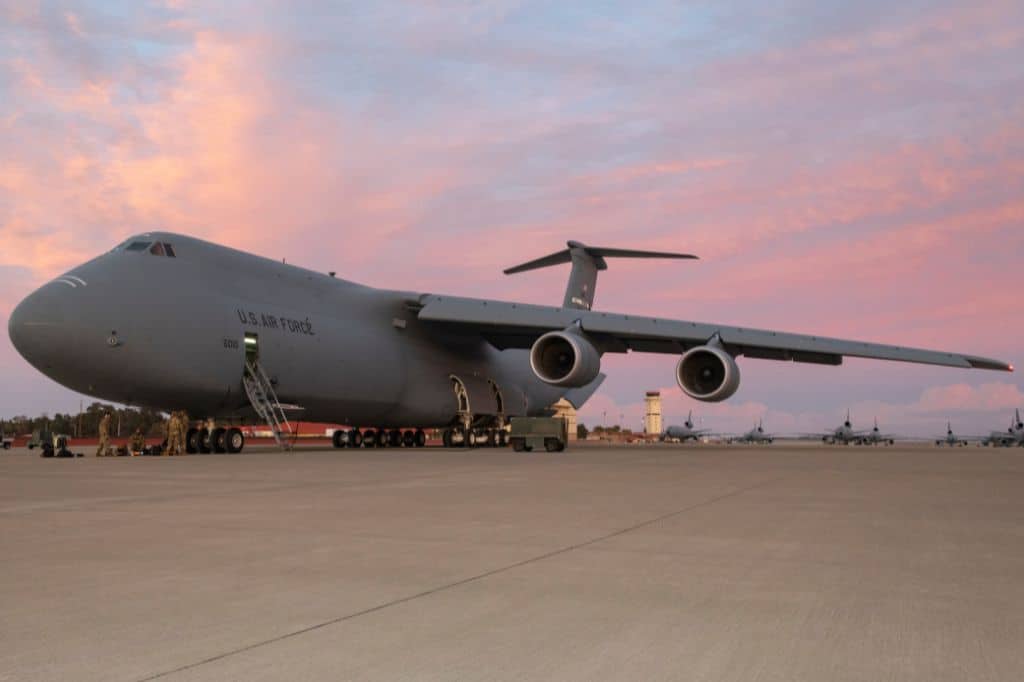
Wondering what type of planes are used for military Space-A flights? This is a common question, but even though we use the term “Space-A flights” loosely, it’s a misnomer: there are no military flights that are just for Space-A passengers.
Flying Space-A means you’re catching a ride on a military mission that has extra seats. If the mission has spare room after all cargo and space-required passengers have been accommodated, the extra seats are often released to eligible Space-A passengers.
With that in mind, you could “hop” any military aircraft that releases seats. This article explains what aircraft you’re most likely to encounter and what to expect onboard. At the end, read our tips for how to dress and pack for a comfortable ride on a cargo aircraft.
Patriot Express Missions
Let’s get this one out of the way first. The Patriot Express (“PE” or “rotator”) is a commercial charter flight used primarily to transport space-required passengers to overseas duty stations. This article has all the details about flying Space-A on the rotator.
Most Space-A opportunities besides the PE are on military cargo planes, aka “organic aircraft” or “gray tails.” While you could fly on one of more than a dozen different aircraft, the ones below are most common.
C-5 Galaxy
This is the largest aircraft in the Air Force. The passenger seating area is located above the cargo bay. Seats are configured like a commercial airplane, but they face the rear of the aircraft, and you have more legroom.
On a C-5, your checked luggage will remain in the lower level cargo area, and you will stow your carry-on under the seat in front of you. There are no overhead bins on a C-5.
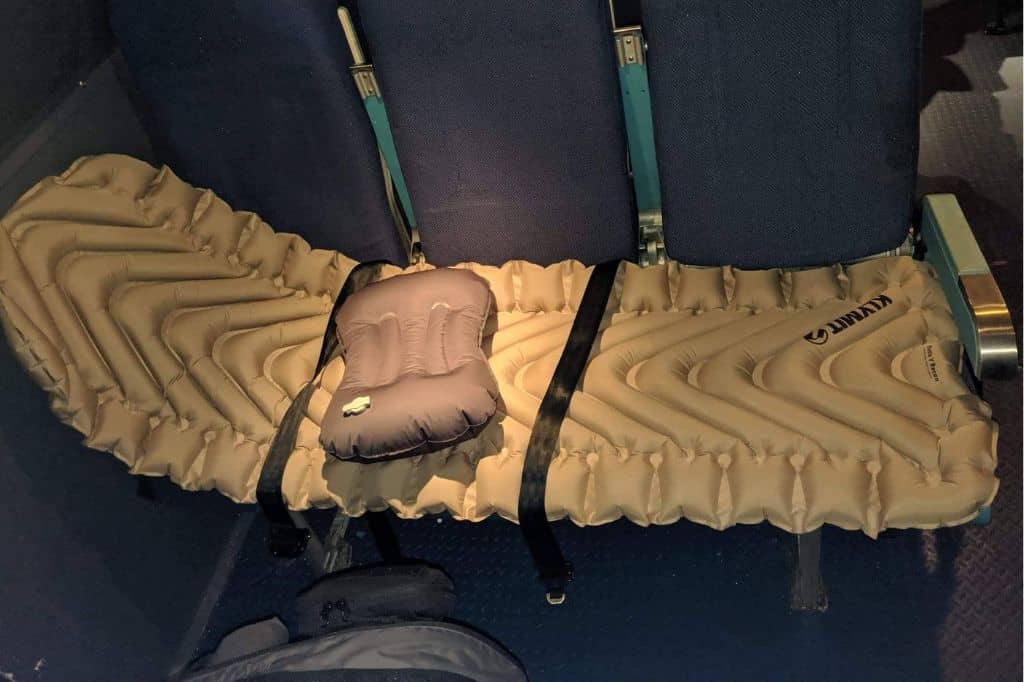
The lavatory is similar to those on a commercial aircraft, minus the running water in the sink. The rows closest to the lavatory are generally the warmest section of the seating area, while the sections farthest away are usually cold.
One important thing to note about a C-5 is that there are two possibilities for boarding and deplaning. Under normal circumstances, you use a staircase truck from the flight line. That staircase has 36 steps, and you can see a picture of it in this Air Mobility Command brochure.
However, if it’s windy or a staircase truck is not available, you will climb/descend a very steep ladder between the two levels of the aircraft. Keep in mind that you may need to do so carrying your backpack, child, carseat, etc.
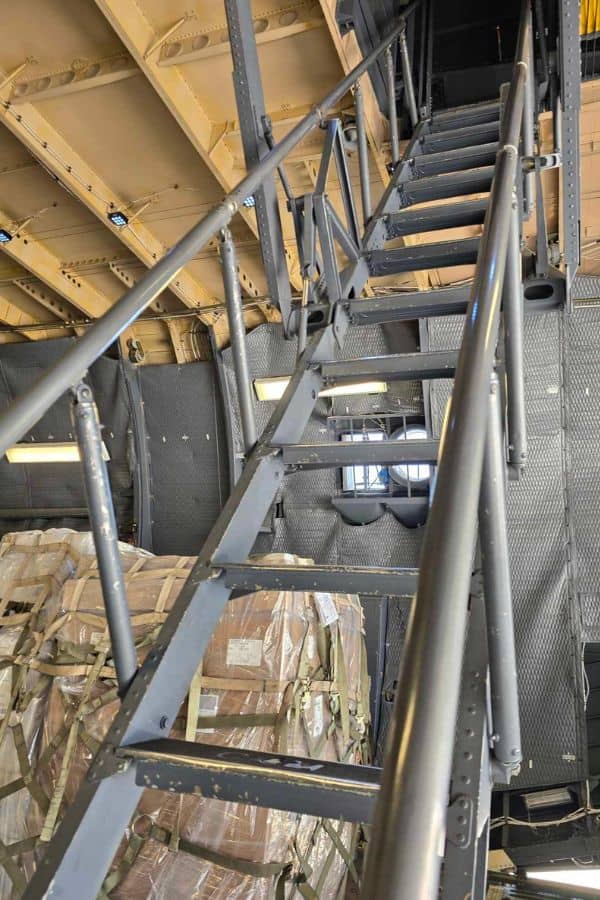
I recommend reviewing AMC’s brochure and the photo above before competing for a Space-A opportunity on a C-5.
C-17 Globemaster
Another large cargo aircraft, a C-17 can have different seat configurations.
Most often, passengers are sitting in jump seats along the sides of the aircraft (facing the middle). Sometimes the plane is packed to the gills with cargo. Other times, the only cargo in sight is your checked luggage strapped to the floor.
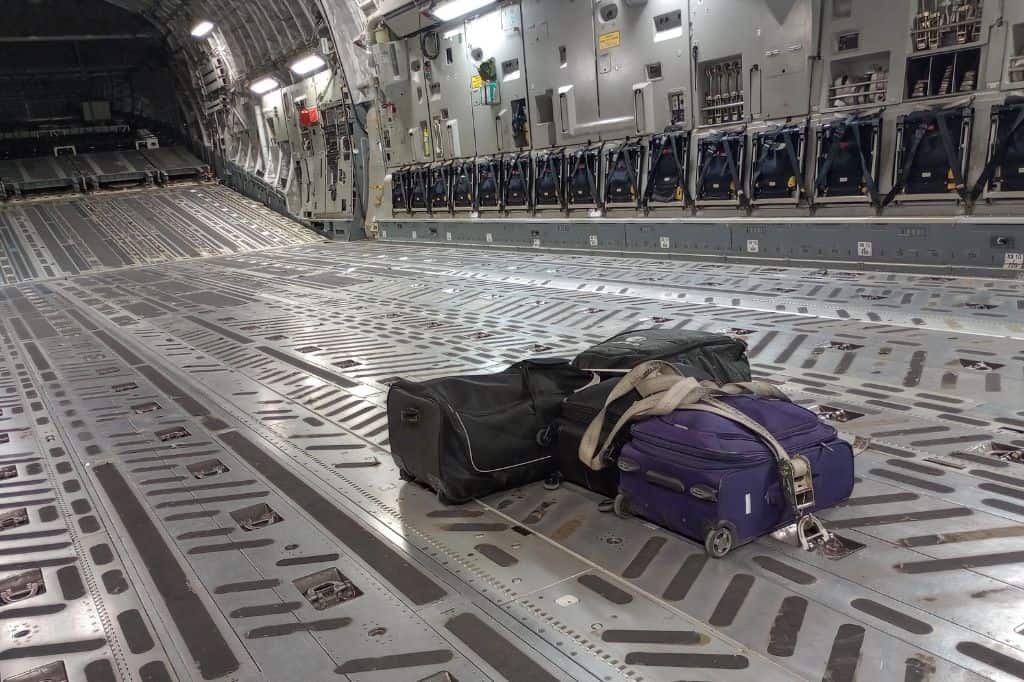
With this configuration, you can lie down wherever there is space on the floor (or across the seats) after the plane reaches altitude and the crew authorizes you to do so.
We’ve also flown in a C-17 configured with regular passenger seats filling most of the cargo bay. Some passengers chose to sit along the sides anyway, but we preferred real seats to jump seats. With that configuration, there was very little space to lie on the floor.
Lavatories on C-17s are similar to C-5s. Sometimes they are built into the aircraft, other times they were more like porta-potties. Either way, they do not have running water in the sink.
C-17s are most often very cold, but it can depend on where you’re sitting relative to heating vents. Most often, you will board a C-17 from the flight line by climbing a short staircase connected to the aircraft door.
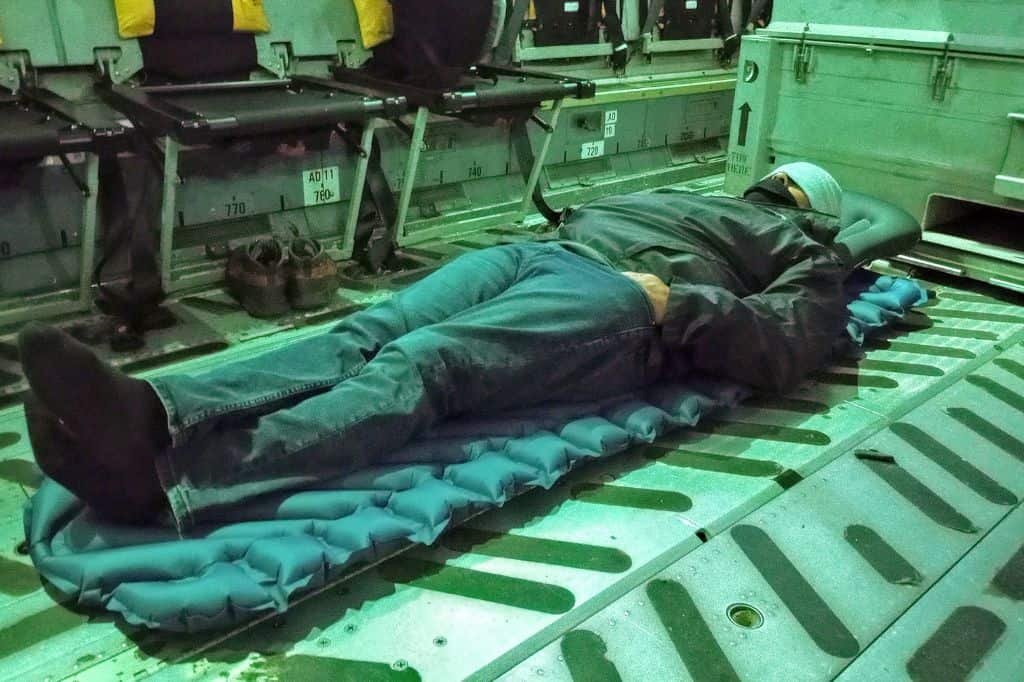
C-130
This a prop plane, so it is noisier, slower, and bumpier than a C-17. It has the open bay configuration with jump seats along the sides, but it’s much smaller. If there is room on the floor, you can lie down like on a C-17.
The bathroom facility on a C-130, affectionately known as the “honey bucket,” is simply a portable toilet located along the wall next to the jump seats. It’s a step up from the floor and is shielded by a “privacy curtain.”
C-130s are most often used for shorter distances within a region (for example, we hopped one from Ramstein AB to NAVSTA Rota). If you’re competing for a transoceanic mission on a C-130, know that the flight time is significantly longer than the same route on a C-5 or C-17, for example.
Similar to a C-17, you board a C-130 by ascending a few steps from the flight line.
KC-135
These are tankers used to fuel other aircraft while in flight, and they may perform that mission with Space-A passengers on board.
KC-135s have jump seats along the sides of the aircraft, and much of the middle area is filled with cargo. The front of the aircraft has more space on the floor, but that floor is extremely cold due to the fuel stored beneath it.
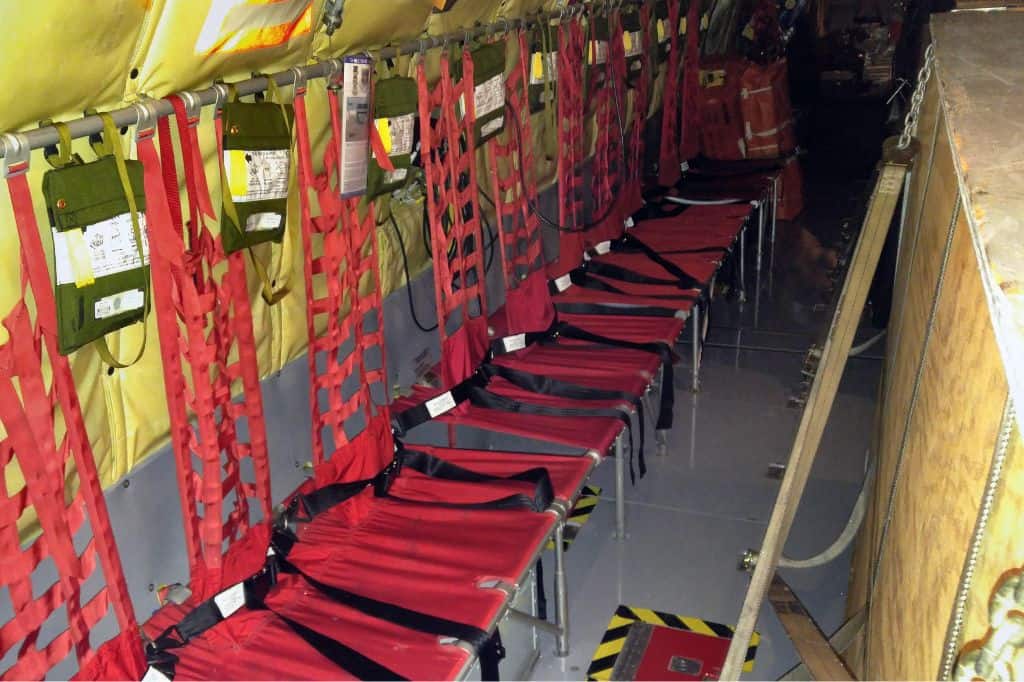
If you hop a KC-135 and it’s not full of passengers, you will find that your most comfortable rest is lying across multiple seats. We flew this way from Japan all the way to Germany and arrived well-rested after multiple legs on KC-135s!
The lavatory of a KC-135 is similar to a C-5 or C-17, and you board the aircraft from the flight line using a rolling staircase.
If you get lucky, the crew may allow you to experience the “boom pod,” as I did in this video!
“VIP” Aircraft (C-9/C-12/C-21/C-26/C-40)
These aircraft are similar to regular passenger planes. If you have an opportunity to hop one of them, consider yourself lucky!
The only downside is the baggage limitations. On most other aircraft, Space-A passengers can check two bags up to weighing 70 lbs each. But the limit on these aircraft is often much lower due to storage limitations and/or fuel requirements to the destination.
Preparing to Fly on a Military Aircraft

The only refreshment on a military cargo plane is water. If you purchased a meal during baggage check, the crew will give it to you shortly after boarding. Otherwise, make sure you have ready-to-eat snacks in your carry-on.
For all organic aircraft, four other tips apply:
- Dress in layers. It can be very cold or very warm, depending on the type of aircraft, where you’re sitting, and crew preference. We use this layering system so that we can easily adjust to the temperature. I occasionally see passengers wearing shorts, but I don’t recommend it.
- Bring a small, inflatable mat and a blanket or sleeping bag. You can use an inflatable mat like this one to lie on the floor or stretch out across multiple seats. The blanket/sleeping bag is for warmth.
- Bring hand wipes. The lavatory sinks don’t have running water. Instead, there is a pile of antiseptic wipes, but often not enough to last for the entire flight. Bring your own stash of hand wipes.
- Try to keep your hands free to hold the handrail as your board. If you looked closely at the picture of the internal ladder on the C-5, you know why. Use a backpack as your carry on bag.
Here is a full Space-A packing list, which explains exactly what we wear and bring when our travel plans include taking hops!
Ready to Hop a Cargo Flight?
In our opinion, flying Space-A on one of the aircraft above is more comfortable (with the right clothing and gear) and a better adventure than flying Space-A on the Patriot Express.
Many travelers prefer the latter, but our #1 tip when taking military hops is to stay flexible by keeping your options open. That means you’re ready and willing to take whatever mission has seats in the direction you’re headed. So, even if your outbound flight is on the PE, bring the clothing and gear you need in case your first opportunity to return home is on a cargo aircraft.
The appearance of U.S. Department of Defense (DoD) visual information does not imply or constitute DoD endorsement.

Hi,
I’m trying to find a flight to San Juan, Puerto Rico. I live in Orlando Florida and I haven’t been able to find flights. Is there any way you can assist me?
Thank you,
Miguel
The only base that I ever see flights to Puerto Rico is JB Charleston.